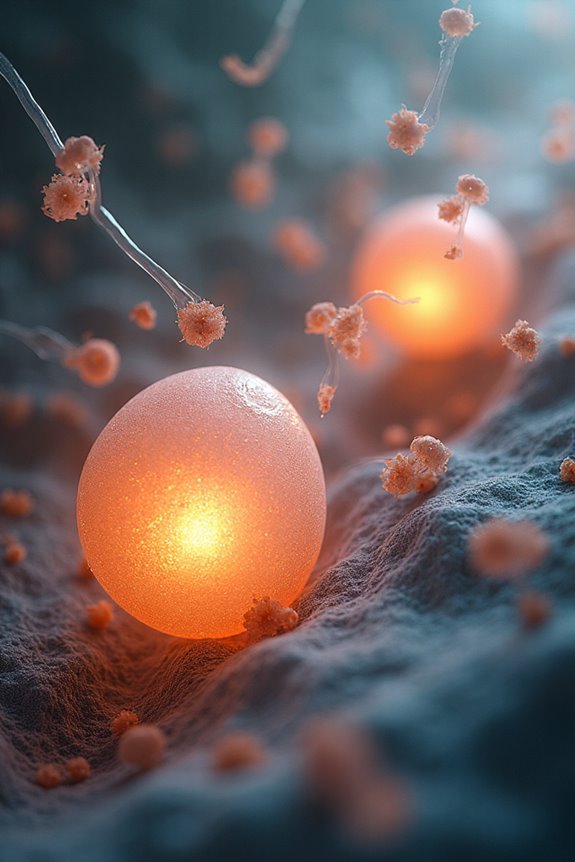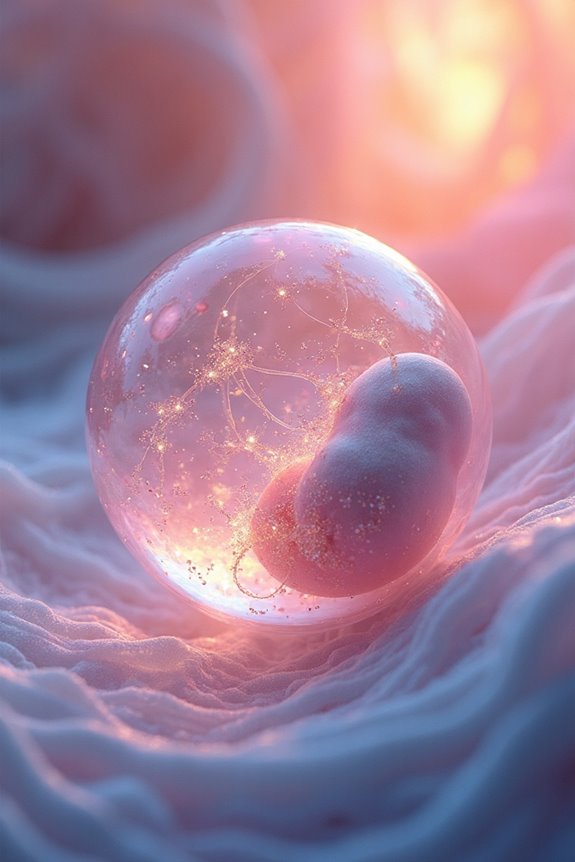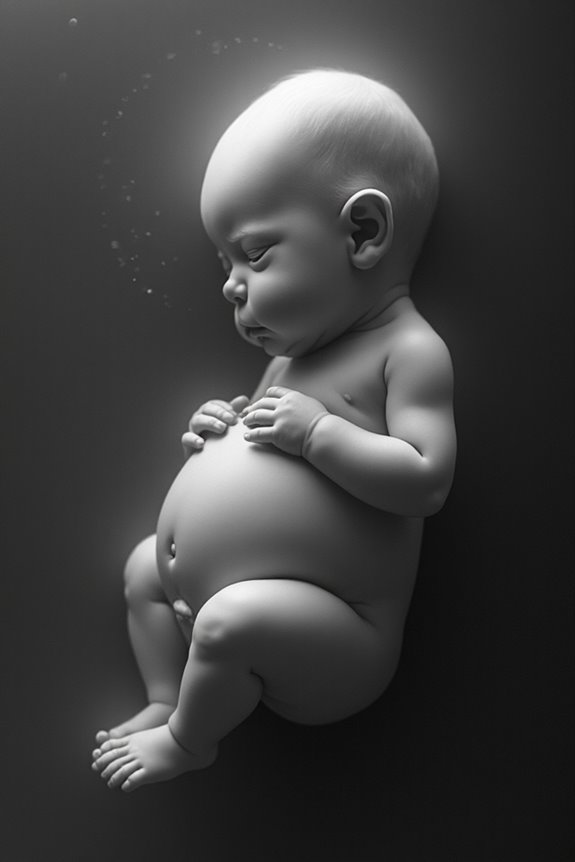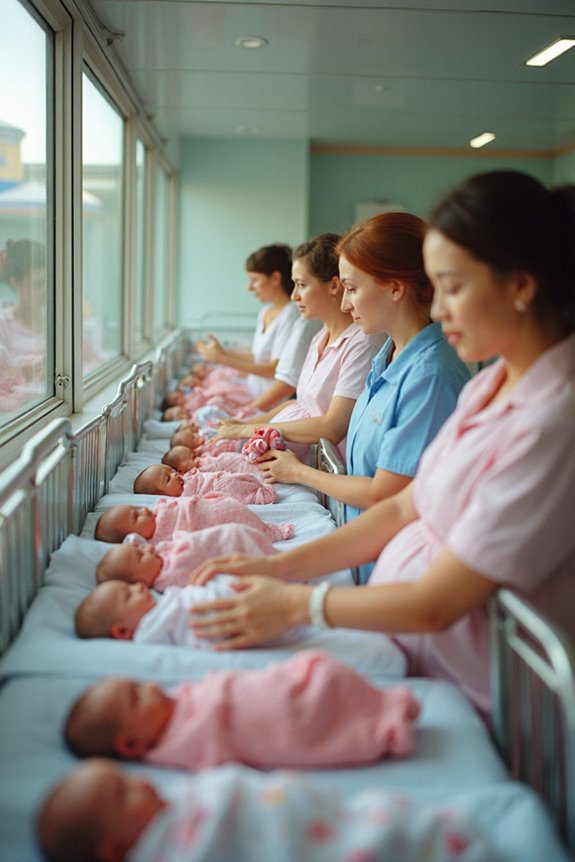Conception is a complex yet fascinating journey that begins when sperm travel through the vas deferens, encountering the female reproductive tract. The egg, maturing monthly, provides half of the needed chromosomes. Fertilization occurs when a sperm penetrates the egg’s barriers and fuses with its membrane. The fertilized egg quickly develops into an embryo, which then travels to the uterus. Here, it implants into the uterine lining, setting the stage for potential new life. There’s so much more to the process, so let’s explore further!
Key Takeaways
- Sperm travel through the vas deferens and are propelled by smooth muscle contractions during ejaculation, entering the female reproductive tract.
- The egg, containing half of the genetic material, is released monthly from the ovaries and has protective layers.
- Sperm encounter barriers like the corona radiata and zona pellucida, requiring enzymes to penetrate and fuse with the egg.
- After fertilization, the zygote undergoes rapid cell division, forming three germ layers that will develop into various body systems.
- The embryo migrates to the uterus, reaching the blastocyst stage and preparing for implantation into the endometrium.
The Journey of Sperm
When we think about how babies are made, it’s fascinating to realize that the journey of sperm involves a complex and remarkable process.
- Sperm Transport: Sperm begin their journey in the epididymis and move through the vas deferens, propelled by smooth muscle contractions. During ejaculation, around 300 million sperm enter the female reproductive tract.
- Sperm Survival: Unfortunately, the acidic environment of the vagina poses significant challenges. Many sperm don’t survive the initial journey, but those that do can live up to five days. The cervical mucus plays a crucial role, thinning during ovulation to aid sperm transport.
Understanding this journey helps us appreciate the intricacies of conception and the remarkable resilience of sperm in their quest to unite with an egg.
The Role of the Egg

The role of the egg in reproduction is fascinating and crucial, as it serves as the female gamete, or reproductive cell. Each month, our bodies prepare for the possibility of new life through a process called egg maturation, where an egg develops in the ovaries.
Here are a few key points about the egg:
- Genetic Contribution: The egg contains our genetic material, providing half of the chromosomes needed for a future child.
- Layers of Protection: It’s surrounded by layers that nourish and protect it, such as the corona radiata and zona pellucida.
- Haploid Nature: Being haploid, the egg holds only half the genetic information, which combines with sperm to create a unique individual.
Understanding the egg’s role deepens our appreciation of conception.
The Process of Fertilization

Fertilization is a remarkable process that kicks off the journey of creating new life, and understanding how it works can be both fascinating and enlightening.
When sperm reaches the egg, it faces fertilization barriers like the corona radiata and zona pellucida. Here’s how it works:
- Sperm Enzymes: Sperm release enzymes, including hyaluronidase, to penetrate these barriers effectively.
- Penetration Process: After breaking through the corona radiata, sperm continue to the zona pellucida, where they must fuse with the egg membrane.
- Genetic Exchange: Once inside, a single sperm delivers its genetic material, initiating the fusion that leads to conception.
This intricate dance of sperm and egg, marked by biochemical signals and receptor activation, ultimately sparks the creation of new life, reminding us of nature’s incredible design.
Early Embryo Development

As we embark on the incredible journey of early embryo development, it’s essential to understand how intricate this process truly is. During the first eight weeks, our cells undergo rapid division, forming three germ layers:
- Ectoderm: This layer gives rise to our nervous system and skin.
- Mesoderm: Here, we see the foundation for our heart and muscles.
- Endoderm: This layer develops into our digestive and respiratory systems.
The Path to Implantation

After the early stages of embryo development, where vital structures are formed, we now shift our focus to the path leading to implantation. During this journey, the embryo undergoes migration from the fallopian tube to the uterus, taking about four days. By days five to six post-fertilization, it reaches the blastocyst stage, preparing for implantation.
- The blastocyst hatches from its protective zona pellucida.
- It begins to interact with the endometrium, the uterine lining.
- This interaction is crucial, especially during the implantation window, typically days six to ten.
The trophectoderm forms and starts invading the endometrium, establishing a connection with maternal blood vessels. This intricate process sets the foundation for a successful pregnancy, as hormonal support maintains uterine receptivity.
Frequently Asked Questions
How Long Does Sperm Survive in the Female Body?
When we think about sperm lifespan within the female anatomy, it’s fascinating to realize they can survive up to five days under perfect conditions. This understanding deepens our appreciation for the intricate dance of reproduction.
What Factors Affect Sperm Motility and Health?
Have we ever considered how our choices shape sperm motility and health? Factors like environmental toxins and sperm morphology can profoundly impact fertility. Let’s prioritize our well-being for a healthier future together, shall we?
Can Multiple Eggs Be Fertilized in One Cycle?
Yes, we can experience multiple ovulation, leading to several egg releases in one cycle. This increases the chances of fertilization, creating beautiful possibilities for life and the joy of potentially welcoming multiples into our family.
What Happens if Fertilization Doesn’t Occur?
If fertilization failure occurs, we face the heartache of unattainable dreams. It reminds us of egg viability’s importance, leaving us to navigate our emotions and seek support as we consider our next steps together.
How Can Hormonal Changes Impact Conception Chances?
We know hormonal fluctuations can greatly impact our chances of conception. Understanding our fertility window empowers us to optimize timing, enhancing the intimate journey we share while navigating the beautiful complexities of creating new life together.





